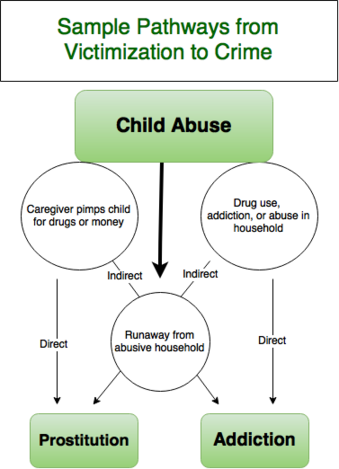Sexual assault is an act in which one intentionally sexually touches another person without that person's consent, or coerces or physically forces a person to engage in a sexual act against their will. It is a form of sexual violence that includes child sexual abuse, groping, rape, drug facilitated sexual assault), and the torture of the person in a sexual manner.
Some victims of rape or other sexual violence incidents are male. It is estimated that approximately one in six men were sexually abused as children. Historically, rape was thought to be, and defined as, a crime committed solely against females. This belief is still held in some parts of the world, but rape of males is now commonly criminalized and has been subject to more discussion than in the past.
Sexual violence is any sexual act or attempt to obtain a sexual act by violence or coercion, act to traffic a person, regardless of the relationship to the victim. It occurs in times of peace and armed conflict situations, is widespread, and is considered to be one of the most traumatic, pervasive, and most common human rights violations.
Victim blaming occurs when the victim of a crime or any wrongful act is held entirely or partially at fault for the harm that befell them. There is historical and current prejudice against the victims of domestic violence and sex crimes, such as the greater tendency to blame victims of rape than victims of robbery if victims and perpetrators knew each other prior to the commission of the crime.
Sex differences in crime are differences between men and women as the perpetrators or victims of crime. Such studies may belong to fields such as criminology, sociobiology, or feminist studies. Despite the difficulty of interpreting them, crime statistics may provide a way to investigate such a relationship from a gender differences perspective. An observable difference in crime rates between men and women might be due to social and cultural factors, crimes going unreported, or to biological factors for example, testosterone or sociobiological theories). The nature of the crime itself may also require consideration as a factor.

The feminist school of criminology is a school of criminology developed in the late 1960s and into the 1970s as a reaction to the general disregard and discrimination of women in the traditional study of crime. It is the view of the feminist school of criminology that a majority of criminological theories were developed through studies on male subjects and focused on male criminality, and that criminologists often would "add women and stir" rather than develop separate theories on female criminality.
Rape is a traumatic experience that affects the victim in a physical, psychological, and sociological way. Even though the effects and aftermath of rape differ among victims, individuals tend to suffer from similar issues found within these three categories. Long-term reactions may involve the development of coping mechanisms that will either benefit the victim, such as social support, or inhibit their recovery. Seeking support and professional resources may assist the victim in numerous ways.
Domestic violence occurs across the world, in various cultures, and affects people across society, at all levels of economic status; however, indicators of lower socioeconomic status have been shown to be risk factors for higher levels of domestic violence in several studies. In the United States, according to the Bureau of Justice Statistics in 1995, women reported a six times greater rate of intimate partner violence than men. However, studies have found that men are much less likely to report victimization in these situations.
Teen dating violence is the physical, sexual, or psychological / emotional abuse within a dating relationship among adolescents. Intimate partner violence (IPV) has been a well examined and documented phenomenon in adults; however, there has not been nearly as much study on violence in adolescent dating relationships, and it is therefore not as well understood. The research has mainly focused on Caucasian youth, and, as of 2013, there are no studies which focus specifically on IPV in adolescent same-sex relationships.

One of the most common forms of sexual violence around the world is that which is perpetrated by an intimate partner, leading to the conclusion that one of the most important risk factors for people in terms of their vulnerability to sexual assault is being married or cohabiting with a partner. Other factors influencing the risk of sexual violence include:
Victimisation is the state or process of being victimised or becoming a victim. The field that studies the process, rates, incidence, effects, and prevalence of victimisation is called victimology.

Domestic violence is violence or other abuse that occurs in a domestic setting, such as in a marriage or cohabitation. Domestic violence is often used as a synonym for intimate partner violence, which is committed by one of the people in an intimate relationship against the other person, and can take place in relationships or between former spouses or partners. In its broadest sense, domestic violence also involves violence against children, parents, or the elderly. It can assume multiple forms, including physical, verbal, emotional, economic, religious, reproductive, or sexual abuse. It can range from subtle, coercive forms to marital rape and other violent physical abuse, such as choking, beating, female genital mutilation, and acid throwing that may result in disfigurement or death, and includes the use of technology to harass, control, monitor, stalk or hack. Domestic murder includes stoning, bride burning, honor killing, and dowry death, which sometimes involves non-cohabitating family members. In 2015, the United Kingdom's Home Office widened the definition of domestic violence to include coercive control.

This article discusses the incarceration of women in correctional facilities. As of 2013, across the world, 625,000 women and children were being held in penal institutions, and the female prison population was increasing in all continents. The list of countries by incarceration rate includes a main table with a column for the historical and current percentage of prisoners who are female.

The incarceration of women in the United States refers to the imprisonment of women in both prisons and jails in the United States. There are approximately 219,000 incarcerated women in the US according to a November 2018 report by the Prison Policy Initiative, and the rate of incarceration of women in the United States is at a historic and global high, with 133 women in correctional facilities per every 100,000 female citizens. The United States is home to just 4% of the world's female population, yet the US is responsible for 33% of the entire world's incarcerated female population. The steep rise in the population of incarcerated women in the US is linked to the complex history of the war on drugs and the US's prison–industrial complex, which lead to mass incarceration among many demographics, but had particularly dramatic impacts on women and especially women of color. However, women made up only 10.4% of the US prison and jail population, as of 2015.

Gender responsive approach for girls in the juvenile justice system represents an emerging trend in communities and courts throughout the United States, Australia and Latin America, as an increasing number of girls are entering the juvenile justice system. A gender responsive approach within the juvenile justice system emphasizes considering the unique circumstances and needs of females when designing juvenile justice system structures, policies, and procedures.
Gender-responsive prisons are prisons constructed to provide gender-specific care to incarcerated women. Contemporary sex-based prison programs were presented as a solution to the rapidly increasing number of women in the prison industrial complex and the overcrowding of California's prisons. These programs vary in intent and implementation and are based on the idea that female offenders differ from their male counterparts in their personal histories and pathways to crime. Multi-dimensional programs oriented toward female behaviors are considered by many to be effective in curbing recidivism.
People in prison are more likely than the general United States population to have received a mental disorder diagnosis, and women in prison have higher rates of mental illness and mental health treatment than do men in prison. Furthermore, women in prisons are three times more likely than the general population to report poor physical and mental health. Women are the fastest growing demographic of the United States prison population. As of 2019, there are about 222,500 women incarcerated in state and federal prisons in the United States. Women comprise roughly 8% of all inmates in the United States.

Sexual assault of LGBT people, also known as sexual and gender minorities (SGM), is a form of violence that occurs within the LGBT community. While sexual assault and other forms of interpersonal violence can occur in all forms of relationships, it is found that sexual minorities experience it at rates that are equal to or higher than their heterosexual counterparts. There is a lack of research on this specific problem for the LGBT population as a whole, but there does exist a substantial amount of research on college LGBT students who have experienced sexual assault and sexual harassment.
There are about 220,000 women currently incarcerated in America. Over 30% of these women are convicted prostitutes. Much of the research on the sex industry in prisons focuses on the experiences of women because the number of jailed female sex workers greatly outnumbers men. Prominent issues that the criminal justice system and women who are incarcerated on prostitution charges currently face include the sexually transmitted infections and diseases epidemic, the sex-work-prison cycle, and the prison-to-sex-trafficking pipeline. Intervention and diversion programs, both within prisons and in traditional and specialty courts aim to address these issues, decrease recidivism, and provide these women with resources to assist them in exiting the sex trade. There are a variety of community-based organizations which seek to help resolve these concerns.

A juvenile sex crime is defined as a legally-proscribed sexual crime committed without consent by a minor under the age of 18. The act involves coercion, manipulation, a power imbalance between the perpetrator and victim, and threats of violence. The sexual offenses that fall under juvenile sex crimes range from non-contact to penetration. The severity of the sexual assault in the crime committed is often the amount of trauma and/or injuries the victim has suffered. Typically within these crimes, female children are the majority demographic of those targeted and the majority of offenders are male. Juvenile sex offenders are different than adult sex offenders in a few ways, as captured by National Incident Based Reporting System: they are more likely to be committed in school, offend in groups and against acquaintances, target young children as victims, and to have a male victim, whereas they are less likely than their adult counterpart to commit rape.









